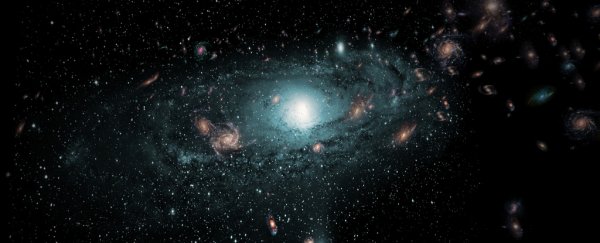Astronomers have used radio waves to peer through the galactic mass and stardust of the Milky Way, and in so doing, have discovered hundreds of nearby galaxies previously hidden from view.
Some 883 galaxies – a third of which had never been seen before – were observed by scientists using the CSIRO Parkes radio telescope in Australia. While the former 'hidden galaxies' are located about 250 million light-years away from Earth, their comparative closeness in astronomical terms effectively means our own local neighbourhood of space just got a whole lot more crowded.
"The Milky Way is very beautiful of course and it's very interesting to study our own galaxy, but it completely blocks out the view of the more distant galaxies behind it," said astronomer Lister Staveley-Smith of the International Centre for Radio Astronomy Research (ICRAR) at the University of Western Australia.
The new-found galaxies lie within an area known as the Zone of Avoidance, so called because our view of this region of space has always been obstructed by the planets and stars that make up the Milky Way. Astronomers have been trying to map the galactic distribution there for decades without success, but thanks to the Parkes radio telescope's receiver, that's no longer the case.
"We've used a range of techniques but only radio observations have really succeeded in allowing us to see through the thickest foreground layer of dust and stars," said researcher Renée Kraan-Korteweg from the University of Cape Town in South Africa. "An average galaxy contains 100 billion stars, so finding hundreds of new galaxies hidden behind the Milky Way points to a lot of mass we didn't know about until now."
And that huge amount of mass could help scientists to understand a cosmic phenomenon taking place within the Zone of Avoidance. The Great Attractor, as it's known by scientists, is a mysterious region of space that appears to be drawing the Milky Way – in addition to hundreds of thousands of other galaxies – toward it.
This anomaly, which scientists believe equates to the gravitational force of a million billion Suns, has puzzled astronomers since it was first discovered back in the 1970s, and the new data on the hidden galaxies could help explain what's going on.
"We don't actually understand what's causing this gravitational acceleration on the Milky Way or where it's coming from," said Staveley-Smith. "We know that in this region there are a few very large collections of galaxies we call clusters or superclusters, and our whole Milky Way is moving towards them at more than 2 million kilometres per hour."
The researchers identified a number of these structures among the hidden galaxies, and being able to study them might help to explain the forces behind the Great Attractor. The findings, reported in The Astronomical Journal, include three galaxy concentrations – called NW1, NW2, and NW3 – and two new galaxy clusters, CW1 and CW2.
"What we see behind the Milky Way is very similar to the rest of the Universe," Staveley-Smith told Stuart Gary at the ABC. "But the density of galaxies in this region seems to be a fair bit higher than in the average region… and this contributes to gravitational tug that the region is able to exert on us and all other nearby galaxies."
